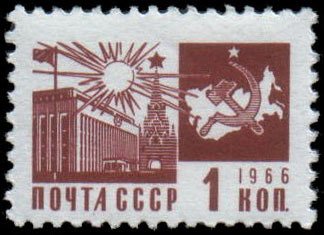Stamp: Kremlin (Soviet Union, USSR 1966)
Kremlin (Soviet Union, USSR 1966)
01 January (Soviet Union, USSR ) within release Society and Technology goes into circulation Stamp Kremlin face value 1 Russian kopek
| Stamp Kremlin in catalogues | |
|---|---|
| Michel: | Mi:SU 3279 |
| Stamp Number: | Sn:SU 3257 |
Stamp is horizontal format.
Congress Palace, Moscow and map of Russia.Also in the issue Society and Technology:
- Stamp - Kremlin face value 1;
- Stamp - Sputnik face value 2;
- Stamp - Worker face value 12;
- Stamp - Women with the dove face value 16;
|
Data entry completed
86%
|
|
|---|---|
| Stamp Kremlin in digits | |
| Country: | Soviet Union, USSR |
| Date: | 1966-01-01 |
| Size: | 26 x 18 |
| Perforation: | 12½ x 12 |
| Emission: | Definitive |
| Format: | Stamp |
| Face Value: | 1 Russian kopek |
Stamp Kremlin it reflects the thematic directions:
A map is a symbolic depiction emphasizing relationships between elements of some space, such as objects, regions, or themes. Many maps are static, fixed to paper or some other durable medium, while others are dynamic or interactive. Although most commonly used to depict geography, maps may represent any space, real or imagined, without regard to context or scale, such as in brain mapping, DNA mapping, or computer network topology mapping. The space being mapped may be two dimensional, such as the surface of the earth, three dimensional, such as the interior of the earth, or even more abstract spaces of any dimension, such as arise in modeling phenomena having many independent variables. Although the earliest maps known are of the heavens, geographic maps of territory have a very long tradition and exist from ancient times. The word "map" comes from the medieval Latin Mappa mundi, wherein mappa meant napkin or cloth and mundi the world. Thus, "map" became the shortened term referring to a two-dimensional representation of the surface of the world.
A building or edifice is a structure with a roof and walls standing more or less permanently in one place, such as a house or factory. Buildings come in a variety of sizes, shapes and functions, and have been adapted throughout history for a wide number of factors, from building materials available, to weather conditions, to land prices, ground conditions, specific uses and aesthetic reasons. Buildings serve several needs of society – primarily as shelter from weather, security, living space, privacy, to store belongings, and to comfortably live and work. A building as a shelter represents a physical division of the human habitat (a place of comfort and safety) and the outside (a place that at times may be harsh and harmful).
The United Nations Educational, Scientific and Cultural Organization (UNESCO; pronounced /juːˈnɛskoʊ/) is a specialized agency of the United Nations (UN) with the aim of promoting world peace and security through international cooperation in education, arts, sciences and culture. It has 194 member states and 12 associate members,as well as partners in the non-governmental, intergovernmental and private sector. Headquartered in Paris, France, UNESCO has 53 regional field offices and 199 national commissions



